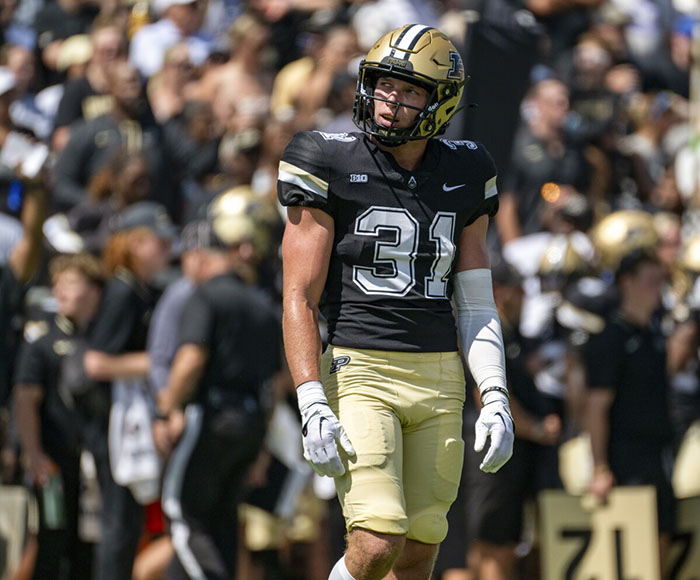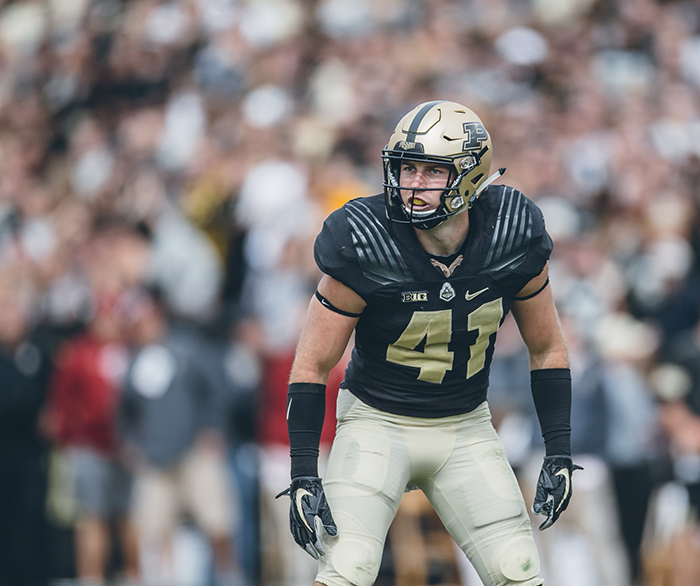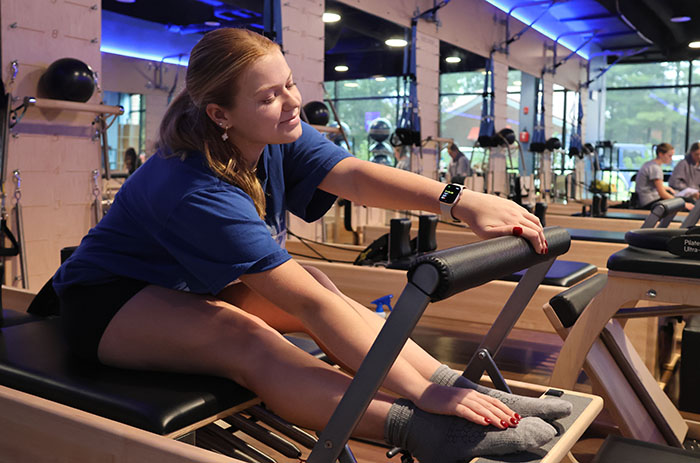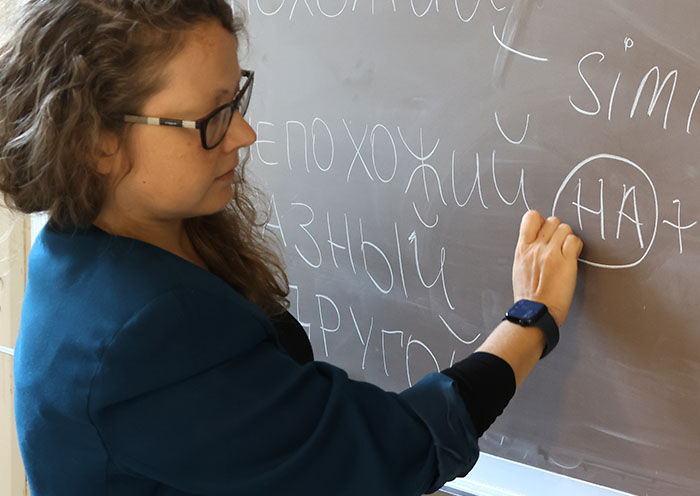Allison Davis
I am a student entering my sophomore year at Indiana University. I am in the Media School studying Media Advertising, along with my minors in marketing and dance.
By Allie Davis, Kadie O’Bannon, Gracie Paul
BLOOMINGTON, Ind. (Nov. 5, 2024) —
Brothers Jake and Dillon Thieneman have been playing football for as long as they can remember. Little did they know that their passion for the game could turn into a revenue-earning career.
This revenue is known as something called NIL, or name, image and likeness.
Jake Thieneman is a former Purdue safety and 2018 graduate, while Dillon Thieneman is a current sophomore safety at Purdue. Jake Thieneman began his journey at Purdue as a walk-on in 2014, and by his fifth year, he had climbed his way to team captain and starter. Dillon Thieneman had a different experience; he graduated high school after his first trimester senior year to begin playing for Purdue in the spring semester. Dillon Thieneman quickly earned his starting position as a true freshman safety. During his first year, Dillon Thieneman was named Third-team All-American, Big Ten Freshman of the Year, and Second-team All-Big Ten.

NIL has been a recurring topic over the past decade. One pivotal event reshaped the discussion: the House v. NCAA settlement. Filed in 2020, this lawsuit was brought by former Arizona State swimmer Grant House and former TCU and Oregon basketball player Sedona Prince, who sued the NCAA for its past ban on athletes getting compensated for their name, image and likeness before 2021. They argued that the ban violated Section 1 of the Sherman Act by restricting athletes’ ability to receive fair earnings. As of May 2024, the NCAA is facing a $2.78 billion settlement, potentially allowing Division I athletes to receive back pay for missed NIL opportunities and aiming to establish a more equitable system for current and future athletes.
The NCAA is expected to grant $1.2 billion, with Power Five Conference schools covering 24% of future withheld revenues. Over the next decade, money will be distributed to athletes who played between 2016 and 2021. If approved, universities would begin payments in July 2025. At the press conference, sports media expert Galen Clavio noted the potential discontent among former players. “A lot of college athletes are going to be arguing that we are in the mid-2000s,” Clavio said, emphasizing that athletes who played before 2016 may question why they aren’t receiving compensation. This sentiment highlights the ongoing uncertainty around the proposal.

Further insight was given in an interview with the Thieneman brothers. Jake Thieneman had an overall positive perspective on the topic, citing the many opportunities NIL creates for players. Though he’s now a graduate, he wishes he’d had this opportunity when he played and believes past players should be compensated for their contributions to their programs. “I think it was unethical to prevent them from being compensated given the value they were providing to the schools and how much revenue they were generating,” he said.
Dillon Thieneman had a different perspective. While he acknowledged the positive effects of NIL, he also pointed out potential downsides. “Athletes are now able to get paid and receive other benefits from their play on the field and presence they have off the field,” he said. However, he added, “people do want to follow the money, and that leads to more people entering the transfer portal to find money for what they think they are worth.” Dillon Thieneman emphasized the growing divide between schools with established NIL programs and those with smaller budgets, resulting in a recruitment imbalance as top players gravitate toward wealthier schools. He also disagrees with the ruling that past players should receive compensation.

Dillon Thieneman shared his experience with securing an NIL deal, noting that the process can be somewhat stressful but rewarding. “The process can be a little stressful, but I enjoy it — getting to try new things like going to the INDY 500 track and recently doing a meal plan deal to receive frequent meals,” he said.
Jake Thieneman, who helped Dillon Thieneman negotiate his NIL deal, provided additional insight into the process. “For the deals between the player and the collective, the player or a representative for the player negotiates with the collective and comes to an agreement on how much they’ll be compensated annually based on the player’s position, their skill level, and their contribution to the team.”

The Thieneman brothers stand on different sides of the NIL discussion.
The debate over NIL continues to evolve daily. With college sports having a constantly growing media presence, this topic isn’t going away anytime soon. While the future remains uncertain, the opportunities for college athletes are only expanding.
https://youtu.be/yHGH3D6HfC4?feature=shared
Voxpop interviews with three strangers on their opinions of the House v. NCAA settlement
FOR IMMEDIATE RELEASE
Media Contacts
Allison Davis
Goldi Baranovsky
Kyiah Johnston
CUPERTINO, California (Sept. 9, 2014) — At today’s launch event, Apple CEO Tim Cook unveiled the Apple Watch, the newest smartwatch on the market with a sleek design and endless personalization opportunities.
Apple introduced its new smartwatch at the annual launch event in Cupertino, California. Leading up to the reveal of the Apple Watch, Tim Cook built anticipation by first introducing new features like Apple Pay and the iPhone 6, showcasing their innovative ideas to enhance user experience. After highlighting these significant products, Cook stated Apple’s launch phrase, “…we have one more thing…” This moment signaled Apple revealing their most recent development and created anticipation in the crowd. “We love to make great products that enrich people’s lives, and we love to integrate hardware, software and surfaces seamlessly,” the CEO said connecting with Apple consumers. After the Apple Watch’s slow introduction video, the audience gave nothing but love to Cook and a standing ovation.
Many consumers were visibly impressed by the innovative features highlighted and seamless integration with the iPhone. The anticipation built by Cook’s statement, “We have one more thing,” increased the excitement, marking the Apple Watch as a significant development in wearable technology. The positive reaction emphasized the product’s potential to reshape consumer expectations. “We believe this product will redefine what people expect from its category… It is the next chapter in Apple’s story,” Cook said. His marketing for the Apple Watch holds a exciting entry into the smartwatch market for Apple, seeing it as a efficient innovation that combined technology, health, and fashion.

One of Apple’s most unique innovations was the User Interface; a new version of the user interface was required when developing the new product. Cook states the importance of incorporating functionality in a mechanism on the Apple Watch called the Digital Crown. This function provides a way to scroll, zoom, and navigate without touching the screen. It also serves as the Home button and a way to access Siri. A new form of communication with Digital Touch has been released. This feature allows users to communicate with each other through taps, drawings, and more—something that has never been done before!
Apple developed an original size and a smaller version with different bands or cases options adjusting to their consumer’s needs. They created distinct collections of Apple Watch: The first Apple Watch polished stainless steel | Apple Watch Sport: The sports collection has an iron exchange coverglass and an anodized aluminum case 60% stronger than the standard (first edition) | Apple Watch Edition: Made from 18-karat gold made up to be twice as hard as standard gold. The Retina Display function features force touch, distinguishing between a tap and a press. The IOS-based interface user interface was explicitly created for the smaller smartwatch. The smartwatch offers customizable watch faces from classic designs to user photos, ensuring the watch is set to change how we stay connected and express our style.
“The Apple watch is made to be worn, and it can be worn all day for any occasion. It’s much more about personal technology than style and taste. It seamlessly combines materials, software, and technology.” Cook stated, emphasizing the personalization of a smartwatch. The watch offers a fitness app that monitors all your activity, heart rate, and movement throughout the day and a workout app that allows you to set specific goals for the type of exercise. The smartwatch empowers users to take control of their health and stay in touch without using their phones. Apple also worked hands-on with developers to access third-party notifications. “We love to make technology more personal and allow our users to do things they could never imagine,” Cook said.

The 2014 release of the Apple Watch increased consumer awareness of wearable technologies and features within smartwatches, revolutionizing the smartwatch market. Apple turned its attention away from the watch’s design appeal and toward its fitness and health capabilities. The workout and fitness functions of the Apple Watch drew in new customers. Two hundred million consumers could utilize the Apple Watch since Apple made it compatible with the iPhone 5 through 6 during the development process. It is designed to be simple to charge at night. It includes an inductive charging magnet connecting seamlessly to the watch’s back.
The Apple Watch took years to develop and has continued to improve. “Creating beautiful objects that are simple and pure as functional has always been our goal at Apple. We designed the Apple Watch as a whole range of products… I think we’re now at a compelling beginning designing technology to be worn and truly personal,” Apple stated. Apple is known for producing innovative products, and the Apple Watch is yet another successful example of that.
###